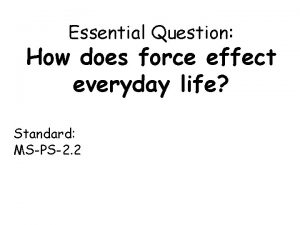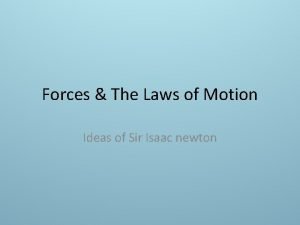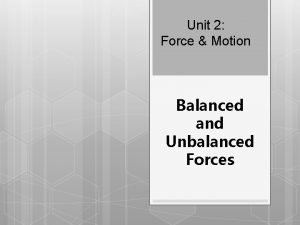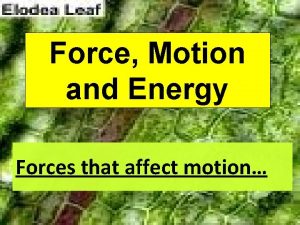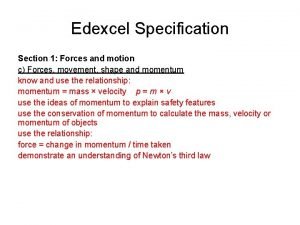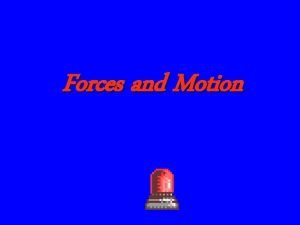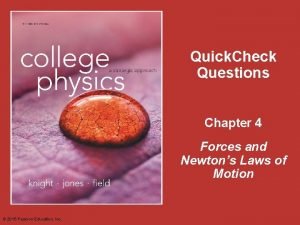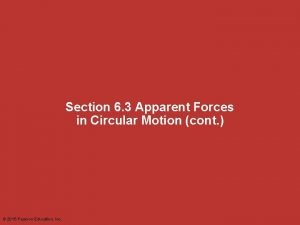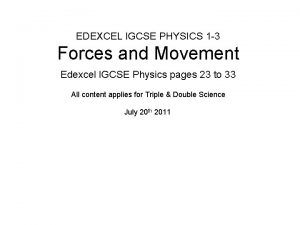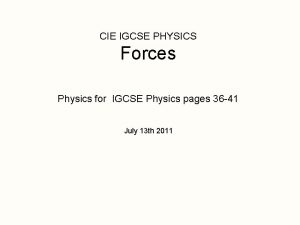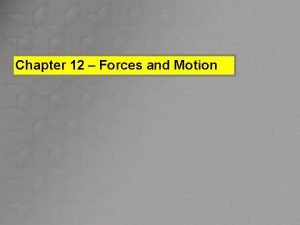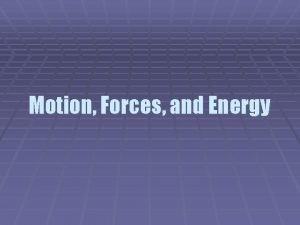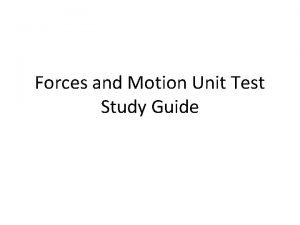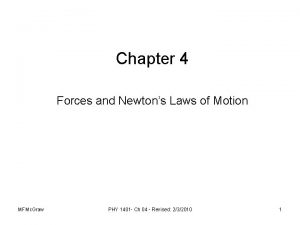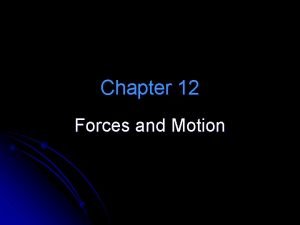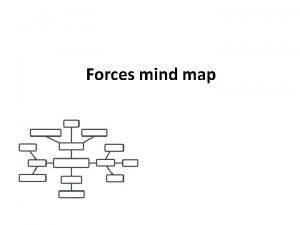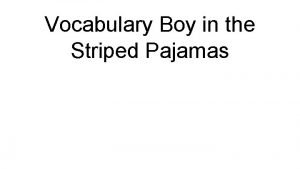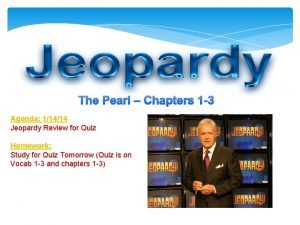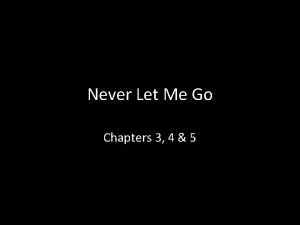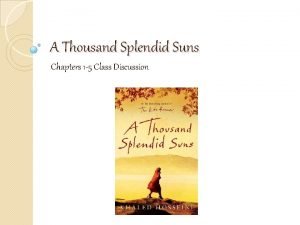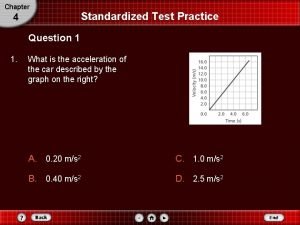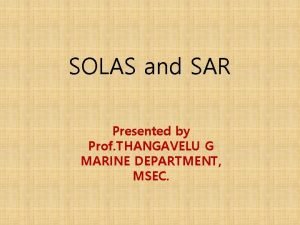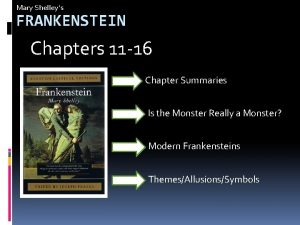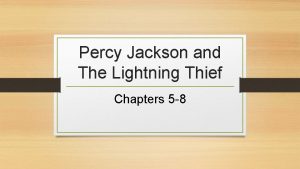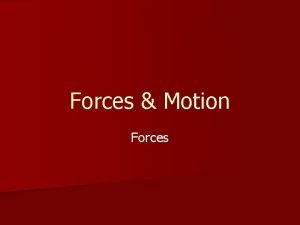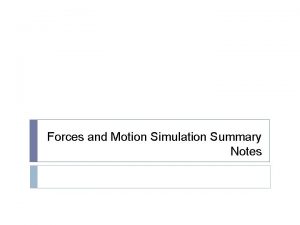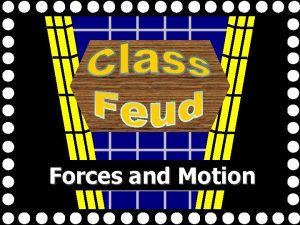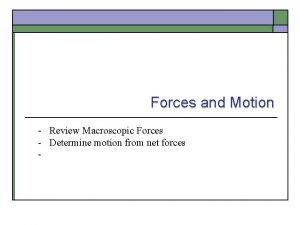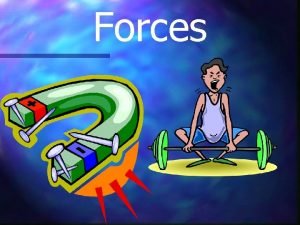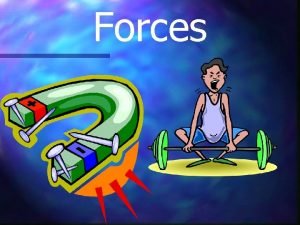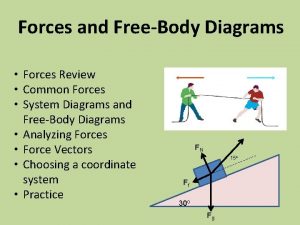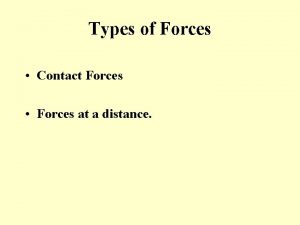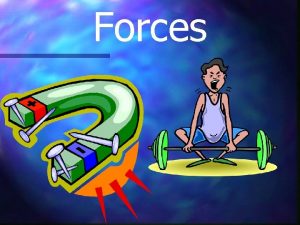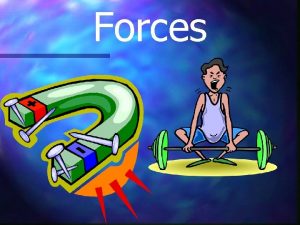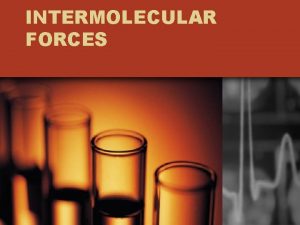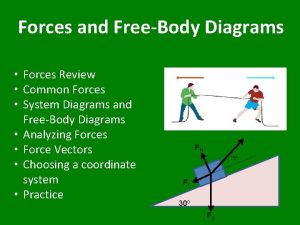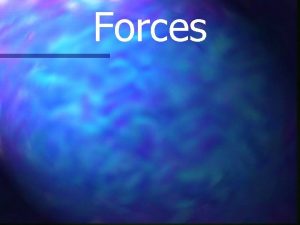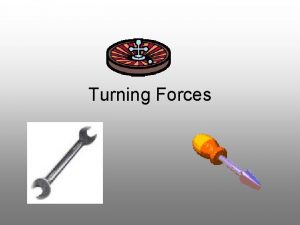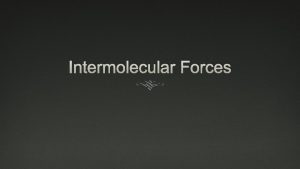Forces Motion Chapters 2 3 Motion 1 Motion








































- Slides: 40

Forces & Motion Chapters 2 & 3

Motion 1. Motion is a change in position 2. Reference points are necessary

Displacement vs. distance * Distance – how far something moves * Displacement – the distance and direction of an object’s change in position from its starting point

Velocity 1. Speed in a defined direction 2. Velocity can change even if speed is constant as long as direction changes

Acceleration 1. The rate of change of velocity 2. a = (vf – vi) / t or a = v / t 3. Units are m/s/s or m/s^2 4. +a = speeding up; -a = slowing down

Example: constant speed & acceleration

Force § a push or pull that one body exerts on another § What forces are being exerted on the football? Fkick Fgrav

Measuring Forces § Forces are measured in newtons (kg. m/s 2). § Forces are measured using a spring scale.

Force § Balanced Forces § forces acting on an object that are opposite in direction and equal in size § no change in velocity

Force § Net Force § unbalanced forces that are not opposite and equal § velocity changes (object accelerates) Fnet Ffriction Fpull N W N

Concep. Test 1 TRUE or FALSE? The object shown in the diagram must be at rest since there is no net force acting on it. FALSE! A net force does not cause motion. A net force causes a change in motion, or acceleration. Taken from “The Physics Classroom” © Tom Henderson, 1996 -2001.

Concep. Test 2 You are a passenger in a car and not wearing your seat belt. Without increasing or decreasing its speed, the car makes a sharp left turn, and you find yourself colliding with the right-hand door. Which is the correct analysis of the situation? . . .

Concep. Test 2 1. Before and after the collision, there is a rightward force pushing you into the door. 2. Starting at the time of collision, the door exerts a leftward force on you. 2. Starting at the time of collision, the door 3. both of a the above force on you. exerts leftward 4. neither of the above

Friction § force that opposes motion between 2 surfaces § depends on the: § types of surfaces § force between the surfaces

Friction § Four Types of Friction üStatic Friction – force that acts on objects that are not moving. (Couch Potato) üSliding Friction - force that opposes the direction of motion of an object as it slides over a surface. (Ice skating or bobsledding) üRolling Friction – friction force that acts on rolling objects. (Rollerblading) üFluid Friction – force that opposes the motion of an object through a fluid. (Planes flying or submarines traveling)

Friction § Friction is greater. . . § between rough surfaces § when there’s a greater force between the surfaces (e. g. more weight)

Gravity § force of attraction between any two objects in the universe § increases as. . . § mass increases § distance decreases

Gravity § Who experiences more gravity - the astronaut or the politician? § Which exerts more gravity the Earth or the moon? less distance more mass

Gravity § Weight § the force of gravity on an object W = mg W: weight (N) m: mass (kg) g: acceleration due to gravity (m/s 2) MASS WEIGHT always the same (kg) depends on gravity (N)

Gravity § Would you weigh more on Earth or Jupiter? § Jupiter because. . . greater mass greater gravity greater weight

Gravity § Accel. due to gravity § (g) § In the absence of air resistance, all falling objects have the same acceleration! § On Earth: g = 9. 8 m/s 2 elephant feather Animation from “Multimedia Physics Studios. ”

Newton’s First Law § Newton’s First Law of Motion § An object at rest will remain at rest and an object in motion will continue moving at a constant velocity unless acted upon by a net force.

Newton’s First Law § Newton’s First Law of Motion § “Law of Inertia” § Inertia § tendency of an object to resist any change in its motion § increases as mass increases

Newton’s Second Law § Newton’s Second Law of Motion § The acceleration of an object is directly proportional to the net force acting on it and inversely proportional to its mass. F = ma

Newton’s Second Law F m F = ma F m a F: force (N) m: mass (kg) a: accel (m/s 2) 1 N = 1 kg ·m/s 2

Calculations § What force would be required to accelerate a 40 kg mass by 4 m/s 2? GIVEN: WORK: F=? m = 40 kg a = 4 m/s 2 F = ma F m a F = (40 kg)(4 m/s 2) F = 160 N

Calculations § A 4. 0 kg shotput is thrown with 30 N of force. What is its acceleration? GIVEN: WORK: m = 4. 0 kg F = 30 N a=? a=F÷m F m a a = (30 N) ÷ (4. 0 kg) a = 7. 5 m/s 2

Calculations § Mrs. Mathis weighs 600 N. What is her mass? GIVEN: WORK: F(W) = 600 N m=? a(g) = 9. 8 m/s 2 m=F÷a F m a m = (600 N) ÷ (9. 8 m/s 2) m = 61. 2 kg

Concep. Test § Is the following statement true or false? § An astronaut has less mass on the moon since the moon exerts a weaker gravitational force. § False! Mass does not depend on gravity, weight does. The astronaut has less weight on the moon.

Newton’s Third Law § Newton’s Third Law of Motion § When one object exerts a force on a second object, the second object exerts an equal but opposite force on the first.

Newton’s Third Law § Problem: § How can a horse pull a cart if the cart is pulling back on the horse with an equal but opposite force? § Aren’t these “balanced forces” resulting in no acceleration? NO!!!

Newton’s Third Law § Explanation: § forces are equal and opposite but act on different objects § they are not “balanced forces” § the movement of the horse depends on the forces acting on the horse

Newton’s Third Law § Action-Reaction Pairs § The hammer exerts a force on the nail to the right. § The nail exerts an equal but opposite force on the hammer to the left.

Newton’s Third Law § Action-Reaction Pairs § The rocket exerts a downward force on the exhaust gases. § The gases exert an equal but opposite upward force on the rocket. FG FR

Newton’s Third Law § Action-Reaction Pairs § Both objects accelerate. § The amount of acceleration depends on the mass of the object. F m § Small mass more acceleration § Large mass less acceleration

Universal Forces § Electromagnetic Forces – are associated with charged particles. The only force to attract and repel.

Universal Forces § Nuclear Forces – act within the nucleus of an atom to hold it together, strong and weak.

Universal Forces § Gravitational Forces – attractive forces that act between any two masses. § “Every object in the universe attracts every other object. ” – Newton’s Law of Universal Gravitation.

Centripetal Force § Centripetal force is a center-directed force that continuously changes the direction of an object to make it move in a circle. This explains how the moon and satellites stay in orbit

“The Tide Is High…” § The gravitational pull from the moon produces two bulges in the Earth’s oceans. One is on the side closest to the moon, and the other is on the side farthest away from the moon.
 Inter vs intramolecular forces
Inter vs intramolecular forces The forces shown above are
The forces shown above are Contact vs noncontact forces
Contact vs noncontact forces Intramolecular forces vs intermolecular forces
Intramolecular forces vs intermolecular forces Balanced forces and unbalanced forces venn diagram
Balanced forces and unbalanced forces venn diagram Difference between intramolecular and intermolecular
Difference between intramolecular and intermolecular Destructive process examples
Destructive process examples What are like parallel forces
What are like parallel forces Study jams forces and motion
Study jams forces and motion Forces and the laws of motion problem b
Forces and the laws of motion problem b A girl pushing a cart balanced or unbalanced
A girl pushing a cart balanced or unbalanced Chapter 9 motion and energy answer key
Chapter 9 motion and energy answer key What forces can affect motion in plants
What forces can affect motion in plants Mass x velocity
Mass x velocity Forces and motion jeopardy
Forces and motion jeopardy Forces that change motion quick check
Forces that change motion quick check A physics textbook swings back and forth as a pendulum
A physics textbook swings back and forth as a pendulum Forces and motion igcse
Forces and motion igcse Force igcse
Force igcse Laws of motion
Laws of motion Motion forces and energy
Motion forces and energy Force and motion unit test
Force and motion unit test Chapter 11 section 3 motion and force answer key
Chapter 11 section 3 motion and force answer key Forces and motion summary
Forces and motion summary Balanced force examples
Balanced force examples Chapter 12 forces and motion
Chapter 12 forces and motion Forces mind map
Forces mind map The boy in the striped pajamas vocabulary
The boy in the striped pajamas vocabulary To kill a mockingbird chapters 10-11
To kill a mockingbird chapters 10-11 The pearl vocabulary chapters 1-3
The pearl vocabulary chapters 1-3 Never let me go chapter 3
Never let me go chapter 3 Fictional character chap 1
Fictional character chap 1 4 standardized test practice answer key
4 standardized test practice answer key Why did scout rub walter cunningham’s nose in the dirt
Why did scout rub walter cunningham’s nose in the dirt Chapters 8-9 to kill a mockingbird
Chapters 8-9 to kill a mockingbird Freak the mighty vocabulary chapters 1-4
Freak the mighty vocabulary chapters 1-4 Solas all chapters
Solas all chapters Daniel keyes short stories
Daniel keyes short stories Frankenstein summary chapter 11
Frankenstein summary chapter 11 Active reading frankenstein chapters 11-16
Active reading frankenstein chapters 11-16 Percy jackson vocabulary chapters 5-8
Percy jackson vocabulary chapters 5-8








